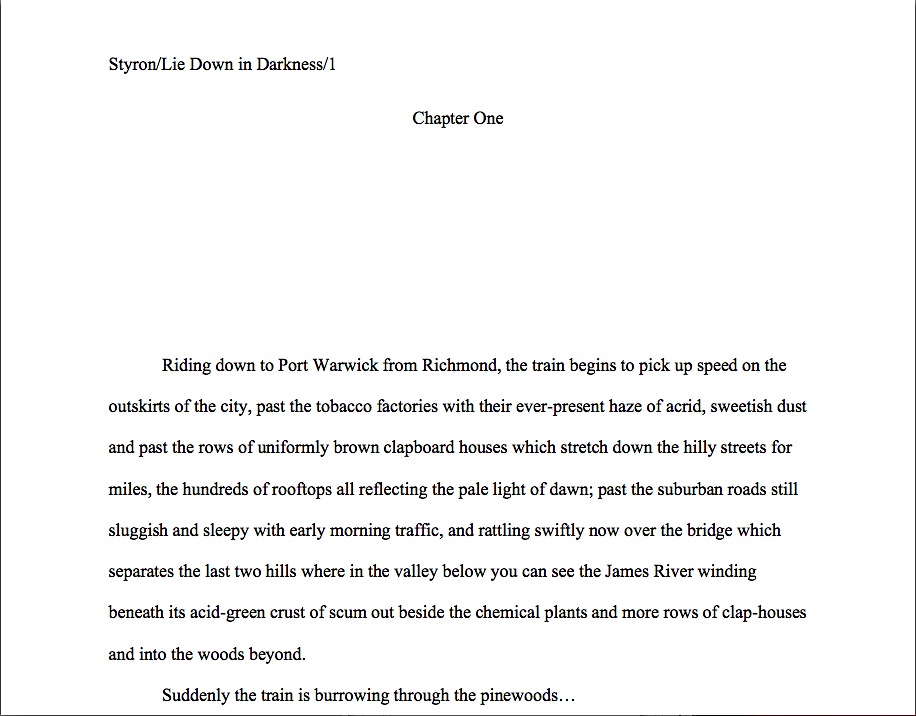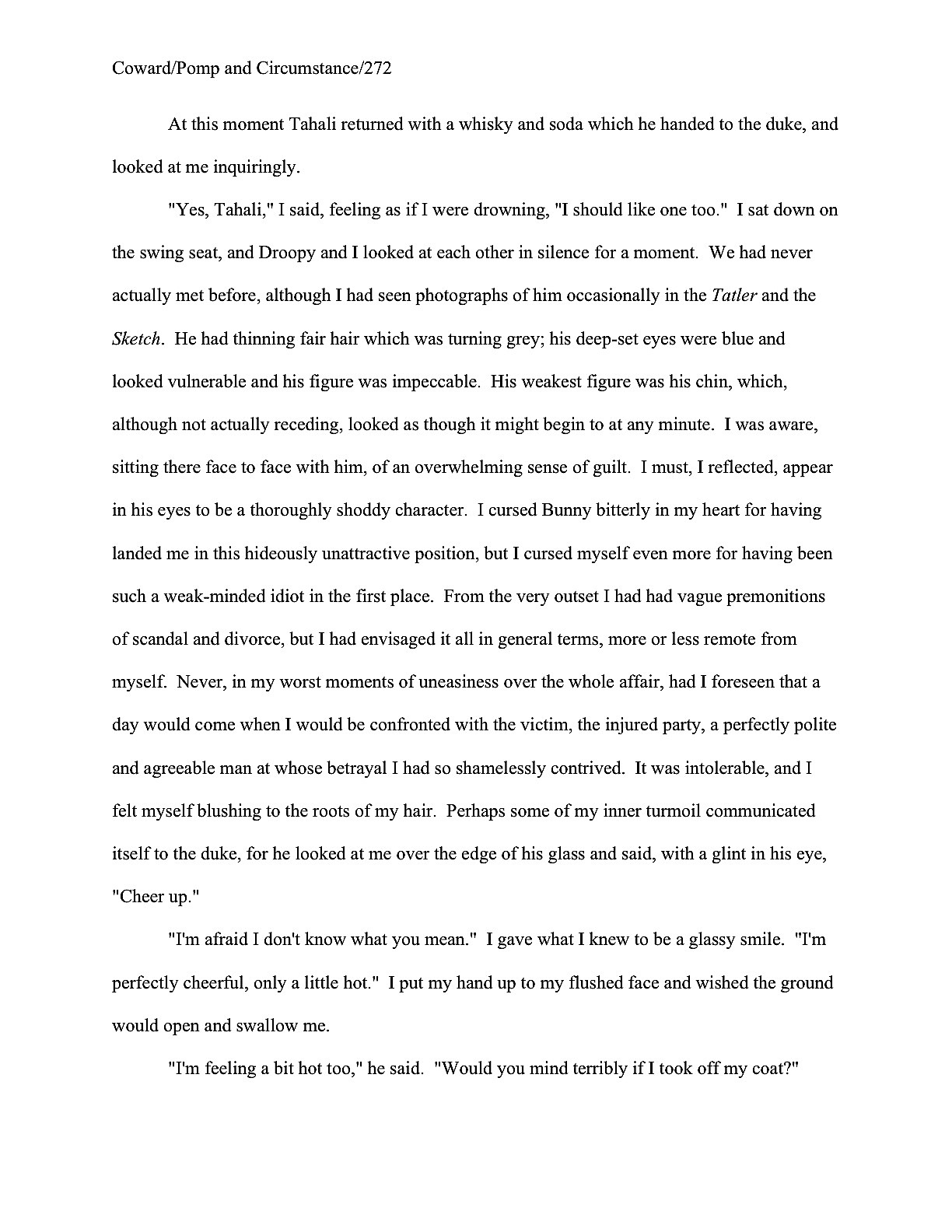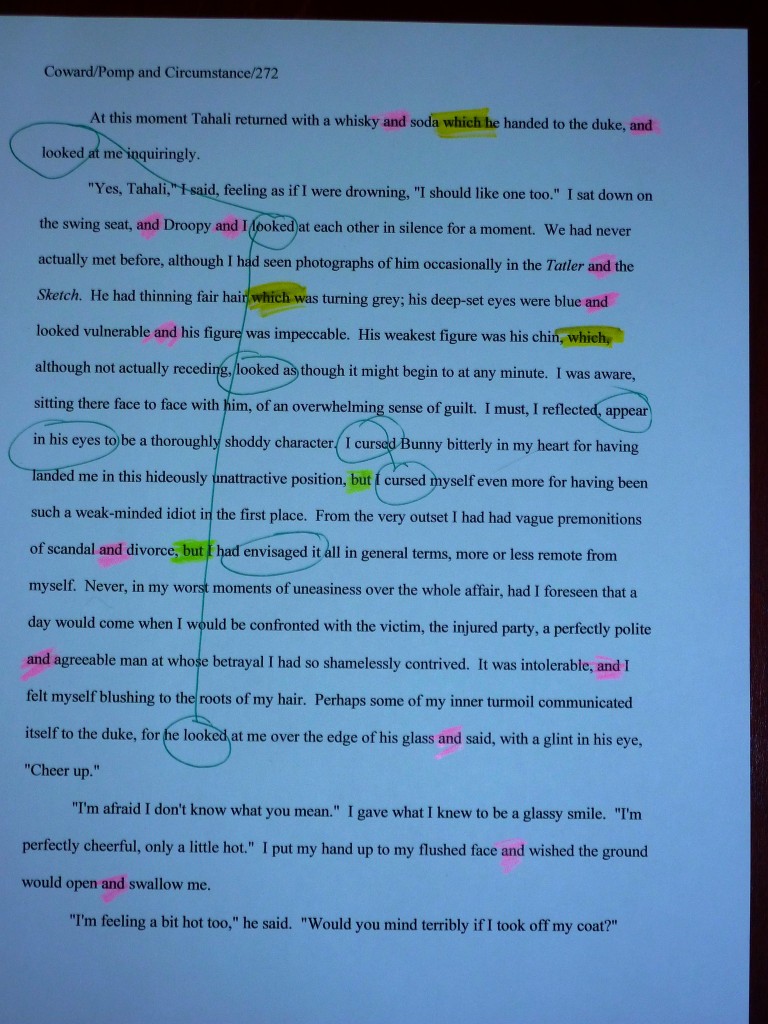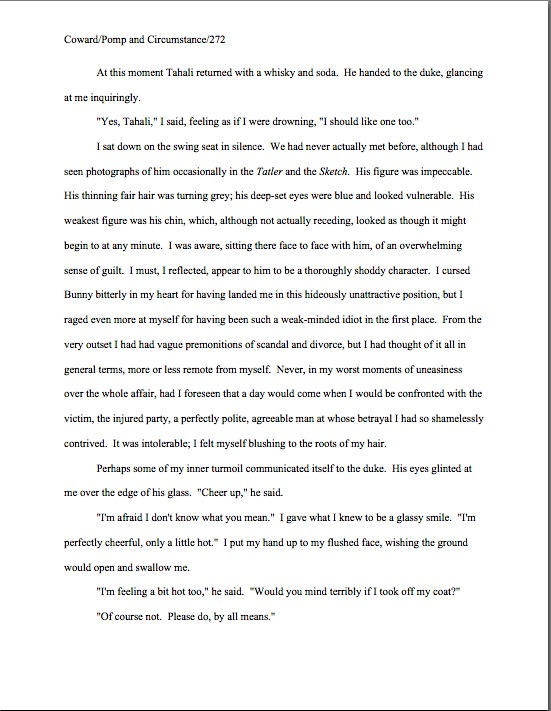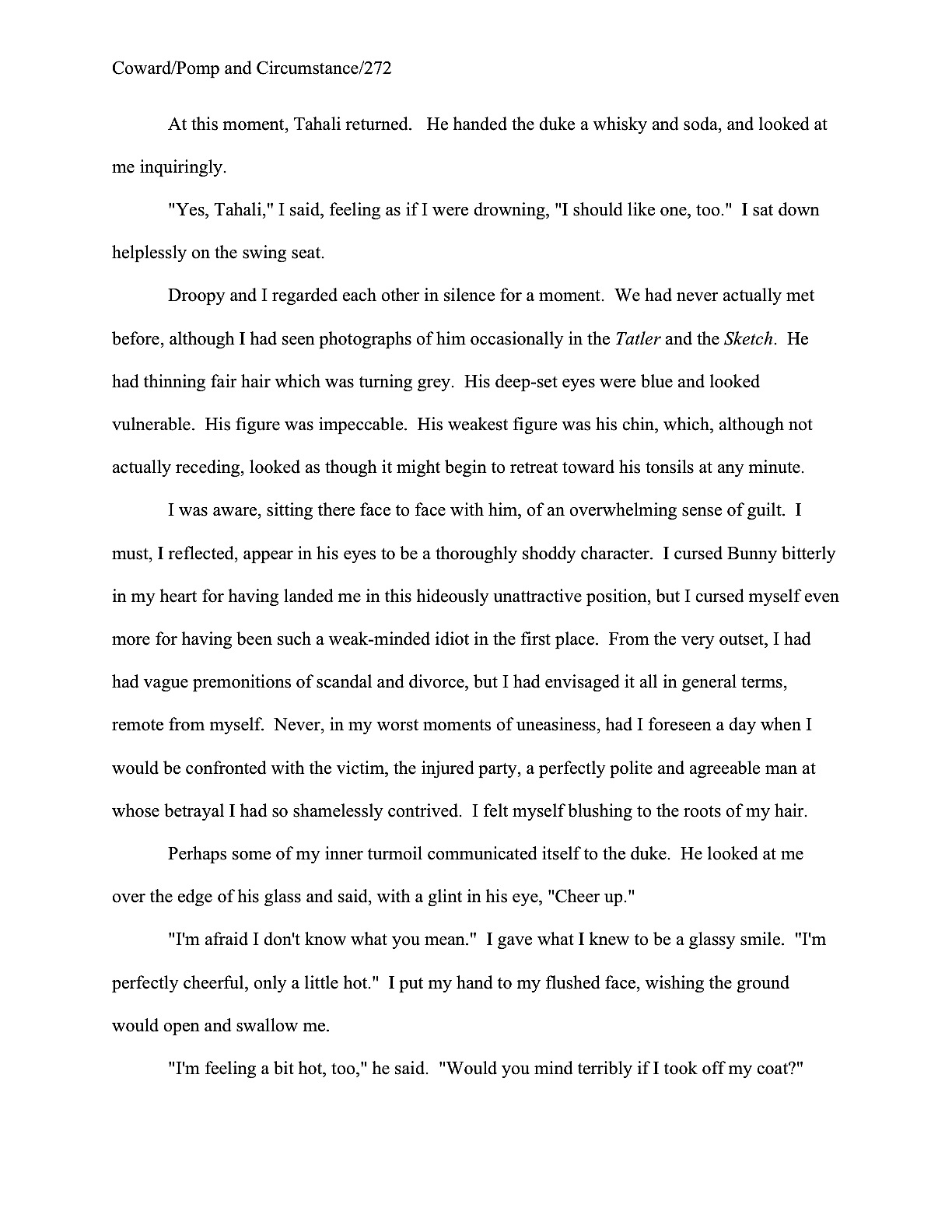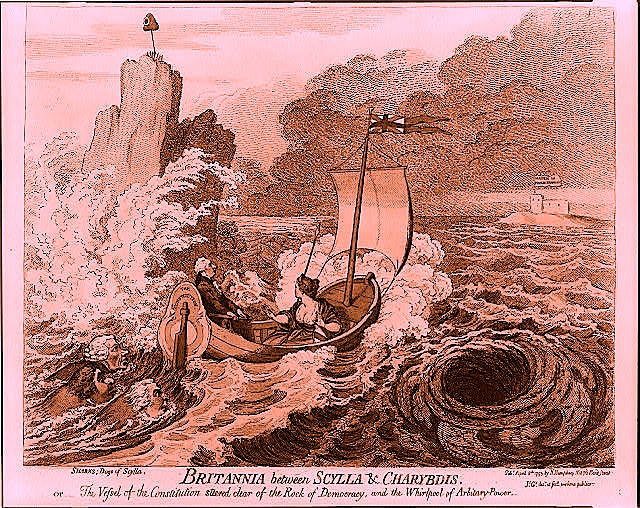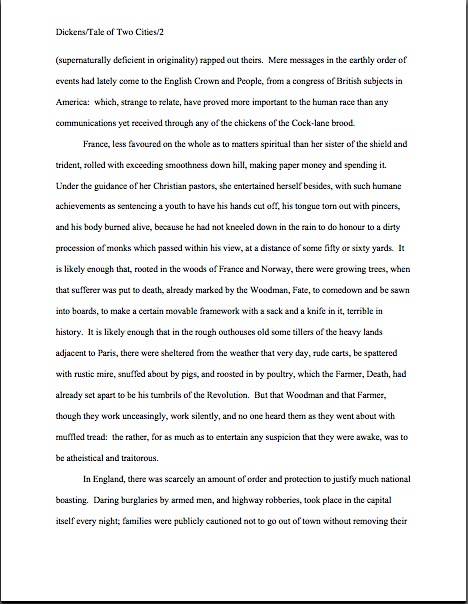Sorry about the unusually lengthy posting hiatus, campers: as the not-particularly-evocative clich? goes, there’s been a lot going on. I know that many of you will be spending the long weekend (or just the weekend) honing your querying, submitting, and pitching skills. Or just indulging in some nice, unbroken writing time. It seemed like a good occasion for a fresh post.
Especially when I had already been devoting quite a bit of thought in my spare moments to the question of narrative voice. Specifically, voice in first-person narratives and the ways in which writers often bend, spindle, and mutilate the rules of grammar ostensibly to make the page read like everyday speech sounds.
Particularly likely to be sacrificed for the sake of speech-like flow: that pesky rule about run-on sentences. It doesn’t just dissolve, you know, when a writer chooses to embrace a first-person voice. As with other deliberate violations of standing rules of grammar, a writer may choose to do it for effect, just so long that she bears in mind that our old pal, Millicent the agency screener, her aunt, Mehitabel the veteran contest judge, and their ilk may disagree with her over whether the effect justifies the means.
Why? Well, slip your tootsies into Millie’s moccasins for a sec and tell me: if you spent your day scanning the first page or two of a hundred submissions, most of which contained at least one typo, misspelling, or grammatical error, would your first response to clapping your eyes upon a page of first-person narrative consisting of paragraph-long sentences be
(1) to exclaim, “This is the most innovative approach to capturing the spoken word upon the page I’ve ever seen!”
(2) to sigh gently and murmur, “Well, it does sound like everyday speech — the copyeditor can always add the necessary punctuation later,” or
(3) to assume that the submitting writer just doesn’t know that run-on sentences are improper?
If, like Millicent, you immediately shouted, “3,” well, at least you have no illusions to be shattered. If you answered, “Why, #2, of course,” on the other hand, you might want to bear in mind that it’s not Millicent’s job to read charitably, nor to select manuscripts with an eye to providing her boss, the agent of your dreams, with extra unpaid editorial work. Professional manuscripts are expected to adhere to the rules of grammar unless there’s a darn good reason that they shouldn’t.
If you answered (1), you have a lovely nature, coupled with a most inadequate literary background. While I suppose it’s not completely beyond the bounds of probability that a screener could come to the job so inexperienced in the history of both the short story and YA that she’s unaware that the single most common means of creating a chatty voice involves stringing sentences together with and, it’s completely impossible that she could hold her job for more than a month without noticing the tendency.
Seriously, if an alien from the planet Targ attempted to learn the rules of written English solely by grabbing a couple of weeks’ worth of submissions from a well-established agency, it might well conclude that this I who seems to narrate so many stories is magically immune to the requirement to use periods. You’d be astonished at the frequency and vim with which your garden-variety first-person manuscript embraces the logic that that (a) everyone who has ever tread the earth’s crust has spoken in run-on sentences and (b) since the point of first-person narration is to sound precisely like people — all people — actually talk, (c) the only possible means of constructing a first-person narrative involves constructing sentences of a complexity and length to cause even the notoriously long-winded-in-a-single-breath Henry James to clutch his chest, gasp for air, and wheeze, “Really?”
To which editors the world over can only shake their heads wearily and concur, if only because (a), (b), and (c) are all demonstrably false. Individuals have been known to sport individualized speech patterns, you know; even if huge swathes of the population do spout and, but, and or constantly, I surely did not have the only mother in the New World who discouraged run-on constructions — as well as split infinitives, the ending of sentences in prepositions, and referring to one’s elders as “Bozo” — in everyday speech. (How else did you think little girls with braids grow up to be editors?)
Besides, can anyone explain the charm of a narrator that sounds like a generic person? Even in the unlikely event that someone actually spoke like a composite dictionary of American standard speech, why would a good writer want to write nothing but run-on sentences? It’s not as though the only goal of first-person narration (or of dialogue, for that matter) is to echo what people actually say, is it?
I’ll take that astonished silence for assent. Which is as it should be, as there are as many ways to construct a first-person narrative voice as there are individual characters up to narrating a book.
Yet in the overwhelming majority of first-person narratives, be they fiction or memoir, the humble conjunction is the hardest-working part of speech. Not that there isn’t some competition, mind you. Habitual word repetition, even if it’s limited to the level common in casual speech, can rapidly become both predictable and a bit dull on the page. Take a gander:
The street was empty and bare, free of chattering folk, the wayward crowd, and the well-advertised pitter-patter of tiny feet, but nevertheless, I conquered my incidentally completely reasonable fear of being hit in the head by a brick and ventured toward the castle. But I soon had reason to regret my own bravery and derring-do, believe you me: the instant I stepped into the crosswalk, a rain of boards, nails, stick-and-daub wall parts, thatch, and masonry hailed upon my head, evidently having made the transition from rain to hail somewhere in flight, the better to pelt and torment me. And yet I moved forward, as inextricably drawn to my ancestral home and its proud and lengthy tradition of revivifying corpses as I felt repelled by the angry and violent mob behind me, waving pitchforks and flaming torches in accordance with local tradition. Prudence, I felt, dictated a swift taking of cover, and my options were limited, so I leapt over the moat and drew up the drawbridge behind me.
Don’t see the problem, since the writing’s actually not bad here? Try reading it out loud. How many of those sentences could you speak in their entirety within a single breath?
While you’re hyperventilating from the attempt, you might want to take note of how often the same words (or different forms of the same words) turn up here. Why, even if we only highlight that most overused of words in manuscripts, and, this passage seems repetitive in both word choice and sentence structure. As Millicent would see it:
The street was empty and bare, free of chattering folk, the wayward crowd, and the well-advertised pitter-patter of tiny feet, but nevertheless, I conquered my incidentally completely reasonable fear of being hit in the head by a brick and ventured toward the castle. But I soon had reason to regret my own bravery and derring-do, believe you me: the instant I stepped into the crosswalk, a rain of boards, nails, stick-and-daub wall parts, thatch, and masonry hailed upon my head, evidently having made the transition from rain to hail somewhere in flight, the better to pelt and torment me. And yet I moved forward, as inextricably drawn to my ancestral home and its proud and lengthy tradition of revivifying corpses as I felt repelled by the angry and violent mob behind me, waving pitchforks and flaming torches in accordance with local tradition. Prudence, I felt, dictated a swift taking of cover, and my options were limited, so I leapt over the moat and drew up the drawbridge behind me.
I would strongly suggest replicating this exercise with several randomly-selected pages in your manuscript, to gain a sense of how Millicent would see your work. Yes, even if you don’t happen to be writing in the first person. Print the page, then circle and each time it appears; while you’re at it, draw a box around each use of those most pervasive of verbs, to be or to have. If you really want to get fancy, underline any word that appears more than once.
Once you’ve finished, prop the page against the back of your desk chair and take a few steps back. How many sentences remain unmarked?
Or, if that test sounds like too much trouble, you could always just scroll back through the bewildering array of examples cunningly tucked into my last few posts. Too great an affection for these multi-purpose words can lead, to run-on sentences, dull action sequences, and contracting nasty warts all over one’s kneecaps.
Well, okay, perhaps not the last. But the results still aren’t pretty, as far as Millicent is concerned. Any reasonably busy professional reader sees and in print so often that there might as well be a WANTED poster with its image plastered on the wall above her desk.
And‘s crime? Accessory to structurally repetitive prose.
Let’s face it: no other word is as single-handedly responsible for text that distracts the eye, enervates the mind, and wearies the soul by saying different things in more or less the same way over and over again on the page. Take, for instance, that immensely popular sentence structure, X happened and Y happened:
Vivian had her cake and ate it, too.
There’s nothing inherently wrong with this sentence, of course, standing alone. Solitude, however, tends not to be and‘s writer-preferred state. A perennial favorite in both submissions and contest entries, the X happened and Y happened sentence structure all too often travels in packs.
Vivian had her cake and ate it, too. Jorge ate what was left of Vivian’s cake and then went out and baked his own. After having tried his cake, Frankenstein’s monster broke into his apartment and destroyed his oven.
“I’m stopping him,” the monster told reporters and the requisite crowd of torch- and pitchfork-wielding locals, “before he bakes again.”
Did you catch it this time? Like any kind of sentence that appears too often within a short run of text, its tends to bore the reader after a while, even if the subject matter is inherently interesting — and yes, Virginia, even if every sentence in the run isn’t put together in precisely the same way. That’s and‘s fault, you know: when too many of them appear on a page, even the untrained eye starts unconsciously counting them.
Oh, turned pale, have you? “But Anne,” the more gifted conclusion-drawers among you quaver, “if I’ve already started toting ‘em up, how does a trained eye like Millicent’s respond? Especially if the ands in question have rampaged all over page 1 of a submission — or even, heaven help us, a query letter?
Good questions both, and they share the same answer what’s the most over-used word in Millicent’s vocabulary? “Next!”
That’s not to say, naturally, that the X happened and Y happened sentence structure doesn’t have some legitimate uses. It is appealing to writers because, let’s face it, it can provide a quick way to inform the reader of quite a bit of action in a short amount of text. Instead of having to write a brand-new sentence for each verb with the same subject, all of the action can be presented as a list, essentially.
That can be especially handy if the individual activities mentioned are necessary to plot, characterization, or clarity, but not especially interesting in and of themselves. Look how quickly we can polish off this string of events:
Weary from a long day at work, Ernie sat down and removed his heavy steel-toed boots.
Nothing wrong with that, right? The reader doesn’t need to spend two sentences mulling over Ernie’s rather predictable post-workday actions. Now, while we’ve got our revision spectacles on, we could debate from now until next Tuesday whether the reader actually needs to be told that Ernie sat down — it’s not exactly a character-revealing move, is it? — but that’s a matter of style, not proper presentation, right? Technically, this is a perfectly legitimate way to convey what’s going on.
Often, though, aspiring writers will present even quite a thrilling string of events in this manner, purely in the interest of telling a tale rapidly. This tactic is particularly popular amongst synopsis-writers trying to compress a complex plot into just a page or two.
ERNIE (27) comes home from work one day, removes his steel-toed boots, and discovers that the third toe on his left foot has transformed into a gecko. He cuts it off in a panic and takes it to a veterinarian, DR. LAO (93). Dr. Lao examines the gecko-toe and determines it has the capacity to knit exquisite sweaters. He and the gecko kill Ernie, go into business together, and soon take the skiwear market by storm.
Not the most scintillating way of describing the story, is it? The repetitive structure gives the impression that none of these potentially quite exciting plot developments is important enough to the story to rate its own sentence. Obviously, that’s a problem in a synopsis, where the goal is to present the story you’re telling as interesting and exciting.
Come closer, and I’ll tell you a secret: it’s a pretty good idea for a narrative voice to present the story it’s telling as interesting and exciting, too. Copying the level of sentence structure and word repetition in everyday speech usually is not the best means of pulling that off.
Why? Well, many actual living, breathing, conversation-producing people do indeed incorporate the X happened and Y happened structure into their speech with great regularity. In many cases, with monotonous regularity. Certainly, it can feel awfully darned monotonous to the reader, if it appears on the printed page with anywhere near the frequency that it tumbles out of the average person’s mouth.
Perhaps less obviously, this structure can create a similarly dismissive impression on a manuscript page. I hate to be the one to break it to you, but skimming eye like You-Know-Who’s will frequently note only the first verb in a sentence and skip the rest.
Before any and-hugger out there takes umbrage at the idea of every sentence in his submission or contest entry’s not getting read in full, let’s take a moment to think about verb-listing sentences from Millicent’s perspective — or, indeed, from any reader’s viewpoint. If an action is not important enough to what’s going on for the writer to have devoted an entire sentence to it, why shouldn’t a reader assume that it’s vital to the scene?
I sense some squirming out there. “But Anne,” some of and‘s partisans hasten to point out, “while I admit that sometimes I lump a bunch of activity together in a few short, list-like sentences in order to speed things up a bit, that’s not the primary way I use and in my prose. As you yourself have mentioned, and not all that long ago, stringing together sentences beginning with but or yet, it creates the impression conversation-like flow. Isn’t that essential for a convincing first-person narrative?”
Chant it with me now, non-partisans: echoing recognizable speech patterns is only one technique for constructing a plausibly realistic first-person narrative voice. Far and away the most popular technique, as it happens. There’s a pretty good reason for that, of course; it would be hard to denying that
I woke up the next morning and poisoned my husband’s cornflakes.
is chatty, casual, echoing the way your local spouse-poisoner is likely to describe her activities to her next-door neighbor, should she happen to wish to confess to the first person she sees afterward. True, it doesn’t quite match the arid eloquence of Ambrose Bierce’s
Early one June morning in 1872, I murdered my father — an act which made a deep impression on me at the time.
But then, what does?
Yes? Do you clever people have anything you’d like to add here? Perhaps the observation that no matter why a word, phrase, sentence structure, and/or narrative device appears over and over again within a short span of text, it’s likely to strike a professional reader as repetitive?
No? Were you instead thinking of my oft-repeated axiom that just because something happens in the real world doesn’t necessarily mean that a transcript of it will make compelling reading?
Despite the sad fact that both of these observations are undoubtedly true, few real-world patterns are rendered with fidelity in writing as often as mundane verbal patterns, especially in dialogue. Social movements come and go unsung, jargon passes through the language literarily unnoted, entire financial systems melt down without generating so much as a mention in a novel — but heaven forefend that redundant or pause-riddled speech should not be reproduced mercilessly down to the last spouted clich?.
Don’t even get me started on the practically court-reporter levels of realism writers tend to lavish on characters who stutter or — how to put this gracefully? — do not cling tenaciously to the rules of grammar when they speak. In some manuscripts, it seems that if there’s an ain’t uttered within a five-mile radius, the writer is going to risk life and limb to track it down, stun it, and pin it to the page with quotation marks.
“I want it to sound real,” writers of this breed shout with engaging earnestness. “My goal is to hold, as ’twere, the mirror up to nature.”
Unfortunately, from Millicent’s perspective, most of these writers don’t realize just how widespread this particular goal is — or that much real-life conversation would be either deadly dull, logically incoherent, or at minimum not literarily interesting transferred directly to the printed page.
Why? Well, for plenty of reasons, but let’s concentrate upon the one most relevant to us today: real-life speakers repeat both words and sentence structures to an extent that would make even the most patient reader rip her hair out at the roots in frustration.
And I’m talking arm hair here, people. If you doubt the intensity of this reaction, here’s a little experiment.
(1) Sit in a crowded caf? for two hours, jotting down the conversations around you verbatim.
No fair picking and choosing only the interesting ones; you’re striving for realistic dialogue, right?
(2) Go home and type up those conversations as scenes, using only the dialogue that you actually overheard.
No cheating: reproduce ALL of it.
(3) Wait a week.
(4) Seat yourself in a comfy chair and read the result in its entirety.
If you can peruse the result without falling into a profound slumber, congratulations! You have an unusually high threshold for boredom; perhaps you have a future as an agency screener. Or maybe you have cultivated an affection for the mundane that far outstrips that of the average reader.
(5) Ask yourself honestly: does the dialogue you overheard contain any entertainment value at all when reproduced in its entirety? Or are only selected lines worth preserving — if, indeed, any lines deserve to be passed down to posterity?
Even if you are lucky enough to stumble upon an unusually witty group of caf? denizens, it’s highly unlikely that you would be able to get the result past Millicent, either as dialogue or as narrative prose. Why? Glad you asked: in professional writing, merely sounding real is not enough; a manuscript must also be entertaining enough to hold a reader’s interest.
Yes, Virginia, even if the manuscript in question happens to be literary fiction, if it’s book-length. Most of what goes on in the real world, and nearly everything that’s said, doesn’t rise to the standards of literature.
Not of good literature, anyway. And that’s as it should be, as far as I’m concerned.
There’s more to being a writer than having adequate transcription skills, after all. Merely reproducing the real isn’t particularly ambitious, artistically speaking. Think about it: wouldn’t you rather apply your unique worldview and scintillating ability with words to create something better than reality?
In that spirit, let’s revisit that sentence structure beloved of the real-life speaker, X happened and Y happened and see if we can’t improve upon it. Why, here’s an example of it wandering by now.
Ghislaine blanched and placed her lily-white hand upon her swiftly-beating heart. Orlando nodded with satisfaction and strode toward her, grinning. She grabbed a poker from next to the fire and glanced around for an escape. He chortled villainously and continued to move closer.
Bugged you that time, didn’t it? Yet each of these sentences is grammatically correct, and this structure reads as though it is merely echoing common spoken English. It’s also pretty much the least interesting way to present the two acts in each sentence: the and is, after all, simply replacing the period that could logically separate each of these actions.
Now let’s take a look at how varying the sentence structure and adding the odd gerund livens things up:
Ghislaine blanched, her lily-white hand clutching her swiftly-beating heart. Orlando strode toward her, grinning. She grabbed a poker from next to the fire and glanced around for an escape. He chortled villainously, moving closer every second.
Easier to read, is it not? Admittedly, the prose here is still pretty purple, or at least a blushing lilac. At least the paragraph is no longer jumping up and down, screaming, “My author knows only one way to structure a sentence!”
Most agents, editors, and contest judges would agree with the paragraph’s assessment of its creator, alas. They tend to have a very low tolerance for over-use of this particular sentence structure. I’ve seen pens poked through manuscripts at the third instance of this kind of sentence within half a page. Screaming has been known to ensue after the sixteenth use within the same space.
If that seems like an over-reaction, consider this: most professional readers go into the job because they like to read. Adore it. Can’t get enough of lovely prose. Lest we forget, people who work at agencies are individuals with personal preferences, rather than the set of automatons sharing a single brain that many aspiring writers presume them to be. I can guarantee, however, that they all share one characteristic: they love the language and the many ways in which it can be used.
Millicent screens manuscripts all day at work, pulls a battered paperback out of her bag on the subway home, and reads herself to sleep at night; her boss totes submissions back and forth on that same subway because he’s so devoted to his job that he does half of his new client consideration at home. And no matter how many manuscripts they reject in a given week, both wake up each and every day hoping that today, at last, will bring an amazing manuscript into the agency, one to believe in and guide forcefully toward other lovers of good literature.
With such an orientation, it’s genuinely frustrating to see a great story poorly presented, or an exciting new voice dimly discernible through a Frankenstein manuscript. Or — and this happens more often than any of us might care to think — when a talented writer was apparently in such a hurry to get a scene down on paper that a series of potentially fascinating actions degenerated into a list that barely hints at the marvelous passage that might have been.
“But Anne,” some of you cry, “I just love the charge-ahead rhythm all of those ands impart to a passage! If the writing is strong enough, the story gripping enough, surely a literature-lover like Millicent would be able to put her repetition reservations aside?”
I see that it’s time to get ruthless: I’m going to have to show you just how much damage an injudicious application of ands can inflict upon even the best writing. To make the lesson sting as much as possible, let’s take the exceptionally beautiful and oft-cited ending of F. Scott Fitzgerald’s THE GREAT GATSBY. To refresh your memory:
And as I sat there brooding on the old, unknown world, I thought of Gatsby’s wonder when he first picked out the green light at the end of Daisy’s dock. He had come a long way to this blue lawn, and his dream must have seemed so close that he could hardly fail to grasp it. He did not know that it was already behind him, somewhere back in that vast obscurity beyond the city, where the dark fields of the republic rolled on under the night.
Gatsby believed in the green light, the orgiastic future that year by year recedes before us. It eluded us then, but that’s no matter — tomorrow we will run faster, stretch out our arms farther… And one fine morning–
So we beat on, boats against the current, borne back ceaselessly into the past.
Even before I finished typing this, I could sense hands shooting up all over the ether. “Aha, Anne! He began two sentences with and! And he used the very X happened and Y happened structure you’ve been complaining about for the last two posts. So you must be wrong about them both, right?”
No, actually — I selected this passage precisely because he does incorporate them; he also uses the passive voice in one sentence. He does it sparingly, selectively.
Look at the horror that might have resulted had he been less variable in his structural choices. (I apologize in advance for this, Scott, but I’m making a vital point here.)
And I sat there brooding on the old, unknown world, and I thought of Gatsby’s wonder when he first picked out the green light at the end of Daisy’s dock. He had come a long way to this blue lawn, and his dream must have seemed so close that he could hardly fail to grasp it. He did not know that it was already behind him, and that it was somewhere back in that vast obscurity beyond the city, and it was where the dark fields of the republic rolled on under the night.
Gatsby believed in the green light, and in the orgiastic future that year by year recedes before us. And it eluded us then, but that’s no matter — tomorrow we will run faster and we will stretch out our arms farther… And one fine morning–
So we beat on, boats against the current, borne back ceaselessly into the past.
Well might you cringe. Even when the writing is very good indeed, structural repetition can be distracting for the reader.
Where might one start to weed out the ands, you ask? Ah, but you’ve already begun doing it; I introduced that exercise above for a reason. All you have to do is expand its use from selected pages to your entire manuscript. Simply scan your pages for sentences in which and appears more than once.
Chances are high that such a sentence will be a run-on, in any case, and thus doubly ripe for revision. So you may be sure to spot it more easily in the wild, a multiple-and run-on will probably look something like this:
In avoiding the police, Babette ran down the Metro stairs and out onto the platform and into the nearest train.
This is a classic run-on — too much information crammed into a single sentence, facilitated by those pesky conjunctions. Ask yourself: is there another, more interesting way I could convey all of this information? If not, is all of this information even necessary?
Some writers, of course, elect to include run-on sentences deliberately in their work, for specific effect: to make the narrator sound less literate, for instance, or more childlike, or to emphasize the length of a list of actions the protagonist has to take to achieve a goal. Sometimes, the point is to increase the comic value of a scene by the speed with which it is described, as in this excerpt from Stella Gibbons’ immortal comedy, COLD COMFORT FARM:
He had told Flora all about his slim, expensive mistress, Lily, who made boring scenes and took up the time and energy which he would much sooner have spent with his wife, but he had to have Lily, because in Beverly Hills, if you did not have a mistress, people thought you were rather queer, and if, on the other hand, you spent all your time with your wife, and were quite firm about it, and said that you liked your wife, and, anyway, why the hell shouldn’t you, the papers came out with repulsive articles headed “Hollywood Czar’s Domestic Bliss,” and you had to supply them with pictures of your wife pouring your morning chocolate and watering the ferns.
So there was no way out of it, Mr. Neck said.
Quite the sentence, eh? (Not the second, silly — the first.) I’m going to part company with pretty much every other editor in the world for a moment and say that I think that a writer can get away with this sort of run-on every once in a while, under three very strict conditions:
(1) If (and only if) it serves a very specific narrative purpose that could not be achieved in any other manner (in this example, to convey the impression that Mr. Neck is in the habit of launching into such diatribes on intimate topics with relative strangers at the drop of the proverbial hat),
(2) If (and only if) it achieves that purpose entirely successfully (not a foregone conclusion, by any means), and
(3) If (and only if) the writer doesn’t use the same device elsewhere — or at least reserves the repetition of this choice for those few instances where including a run-on will have the greatest effect.
Why minimize it elsewhere? Well, as we have seen above, this device tends to create run-on sentences with and..and…and constructions, technically grammatical no-nos. You may be doing it deliberately, but as with any grammatical rule, many writers who do not share your acumen with language include them accidentally.
Let me ask you this: how is a speed-reading Millicent to tell the difference between a literate submitter pushing a grammatical boundary on purpose and some under-read yahoo who simply doesn’t know that run-ons are incorrect?
Usually, by noticing whether the device appears only infrequently, which implies deliberate use, or every few lines, which implies an ingrained writing habit.
I’ve been sensing disgruntled rumblings out there since I uttered point #3. “But Anne,” I hear some of you protest, “I read a great deal, and I see published authors break this rule all the time. Doesn’t that mean that the language has changed, and people like you who go on and on about the rules of grammar are just fuddy-duddies who will be first up against the wall come the literary revolution?”
Whoa there, disgruntled rumblers — as I believe I may have pointed out before, I invented neither the rules of grammar nor the norms of submission evaluation. If I had, every agency and publishing house would post a clear, well-explained list of standard format expectations on its website, along with explanations of any personal reading preferences and pet peeves its staff might happen to have. Millicent would be a well-paid, under-worked reader who could spend all the time she wanted with any given submission in order to give it a full and thoughtful reading; her boss would be able to afford to take on a difficult-to-market book project every month or so, just because he happens to like the writing, and the government — heck, all governments — would issue delightful little checks to compensate writers for all of the time they must now spend marketing their own work.
As simple observation will tell you that none of these matters are under my personal control, kindly take me off your literary hit lists. Thank you.
Even in literary fiction, it’s dangerous to include grammatically incorrect sentences in a submission. To someone who hasn’t read more of your work than the first few pages of your manuscript, it’s impossible to tell whether you are breaking the normal rules of grammar in order to create a specific effect, or because you just don’t know the rule. If an agency screener concludes that it’s the latter, she’s going to reject the manuscript, almost invariably.
Then, too, the X happened and Y happened structure is just not considered very literary writing. So the automatic assumption if it shows up too much is that the material covered by it is to be read for content, rather than beauty of prose.
To reproduce Millicent’s real-life dialogue with grim fidelity: “Next!”
Unless you are getting an extremely valuable effect out of a foray into the ungrammatical, it’s best to save your few opportunities to do so intentionally for when it serves you best. Make sure that two such sentences never appear back-to-back.
Why? To avoid that passage appearing to Millicent as the work of — horrors! — a habitual runner-on, or even — sacre bleu! — the rushed first draft of a writer who has become bored by what’s going on in the scene.
Naturally, neither may be a fair assessment in your case. But when you do find patches of ands in your text, step back and ask yourself honestly: “Do I really NEED to tell the reader this so tersely — or all within a single sentence? Or, indeed, at all?”
“Perhaps,” (you’re still speaking to yourself here, in case you were wondering) “I could find a way that I could make the telling more interesting by adding more detail. I notice by reading back over the relevant paragraphs that my X happened and Y happened sentences tend to be light on vivid specifics.”
My, you’re starting to think like an editor, reader. A Frankenstein manuscript just isn’t safe anymore when you’re in the room.
Since your eye is becoming so sophisticated, allow me to aim it at paragraphs where ands abound in order to consider another possibility: are you rushing through the action of the scene too quickly for the reader to enjoy it? Are some of those overloaded sentences cramming four or five genuinely exciting actions together — and don’t some of these actions deserve their own sentences?
Or, to put it a bit more bluntly, is the repeated use of and in fact your manuscript’s way of saying COME BACK AND FLESH THIS OUT LATER?
C’mon, admit it — almost every writer has resorted to this device at the end of a long writing day. Or when we have a necessary-but-dull piece of business that we want to gloss over in a hurry.
Oh, you thought you were the only one who engaged in such minute-saving tactics? Don’t be so hard on yourself — writers do this all the time. When the point is just to get lines down on a page — or to get a storyline down before the inspiration fades — X happened and Y happened and Z happened is arguably the speediest way/ It’s a perfectly acceptable time-saving strategy for a first draft — as long as you remember to go back later and vary the sentence structure. Oh, and to make sure that you’re showing in that passage, not telling.
When we forget to rework these flash-written paragraphs, the results may be a bit grim. As we have already seen, relying heavily on the ands tends to flatten the highs and lows of a story.
When actions come across as parts of a list, rather than as a sequence in which all the parts are important, the reader tends to gloss over them quickly, under the mistaken impression that these events are being presented in list form because they are necessary to the plot, but none is interesting enough to sustain an entire sentence.
Which, I’m guessing, is not precisely the response you want your sentences to evoke from Millicent, right? Call me psychic — and keep up the good work!


